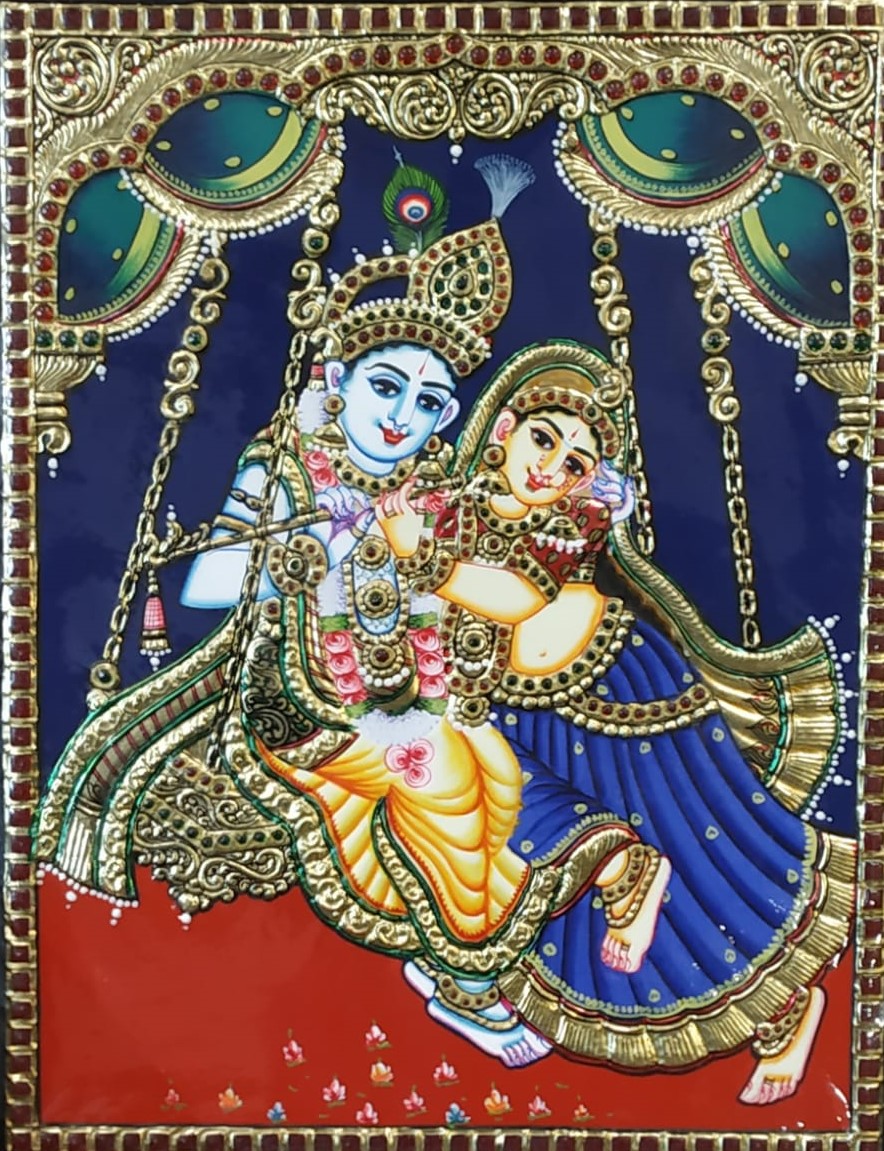
Tanjore Painting - Radha Krishna
Radha Krishna - Tanjore / Thanjavur Paintings
Radha-Krishna (IAST rādhā-kṛṣṇa, Sanskrit: राधा कृष्ण) are collectively known within Hinduism as the combined forms of feminine as well as the masculine realities of God. Radha and Krishna are the primeval forms of God and His pleasure potency respectively in the Gaudiya Vaishnava school of thought. In some schools of Vaishnavism, Krishna is referred to as Svayam Bhagavan, and Radha is illustrated as the primeval potency of the three main potencies of God, Hladini (immense spiritual bliss), Sandhini (eternality) and Samvit (existential consciousness) of which Radha is an embodiment of the feeling of love towards the almighty Lord Krishna.(Hladini). With Krishna, Radha is acknowledged as the Supreme Goddess, it is said that Krishna or God is only satiated by devotional service in loving servitude and Radha is the personification of devotional service to the supreme lord. Various devotees worship her with the understanding of her merciful nature as the only way to attain Krishna. Radha is also depicted to be Krishna himself, split into two, for the purpose of His enjoyment.
It is believed that Krishna enchants the world, but Radha enchants even him. Therefore, she is the supreme goddess of all and together they are called as RadhaKrishna.
While there are much earlier references to the worship of this form of God, it is since Jayadeva Goswami wrote a famous poem Gita Govinda in the twelfth century of the Common Era, that the topic of the spiritual love between the divine Krishna and his devotee Radha, became a theme celebrated throughout India. It is also believed that Radha is not just one cowherd maiden, but is the origin of all the gopis, or divine personalities that participate in the rasa dance.
Radha-Krishna Dev has a special place in the Swaminarayan Sampraday as Swaminarayan himself referred to Radha Krishna in the Shikshapatri he wrote. Further, he himself ordered the construction of temples in which Radha Krishna have been installed as deities. Swaminarayan "explained that Krishna appears in many forms. When he is together with Radha, he is regarded as supreme lord under the name of Radha-Krishna; with Rukmini he is known as Lakshmi-Narayana." The first temple constructed in the sect, built in Ahmedabad in AD 1822, houses the images of Nara Narayana, forms of Arjuna and Krishna, in the central shrine. The shrine on the left of the hall has murtis of Radha Krishna. According to the philosophy of the tradition there were many female companions of Krishna, gopis, but out of all of them Radha was considered to be the perfect devotee. Those who wish to come close to Krishna must cultivate the devotional qualities of Radha. According to theory the sect has set aside Goloka as the supreme heaven or abode (in fact, in some of their temples, such as the Mumbai Temple, the murtis installed are those of Shri Gaulokvihari and Radhikaji), because there Krishna is supposed to be enjoying himself with his Gopis, who according to the Swaminarayana sampradaya the milkmaids with whom Krishna danced; his relations with them symbolize the relation of God with the devotee in reciprocation.
Vigneshwara cannot be broken into two – Krishna (Devanagari: कृष्ण), the eighth incarnation (Avatar) of Vishnu, and his shakti Radha (Devanagari: राधा) such was the love of Radha towards Krishna that they are one. Krishna in Vrindavana is depicted with Radha standing on his left.